Angela Ackerman's Blog: Writers Helping Writers, page 37
May 29, 2023
Free Resources for Writers

By Erica Converso
Free. It���s a wonderful word, isn���t it? A limited budget shouldn���t prevent you from becoming the best writer you can be. And if you use the resources available in your community ��� and outside it on the vast expanse of the internet ��� you���ll find that the possibilities for finding story inspiration and guidance are limitless.
So where should you start? Well, as a former librarian I may be biased, but I���d like to recommend your local library. Of course, this doesn���t seem like particularly original advice ��� everyone knows you can borrow books for free from your local library. But I���ll bet you don���t know just how many books ��� and other materials like movies, music, magazines, and more ��� you have at your fingertips.
Do Your Research with DatabasesCheck your library���s website to find out which databases they offer. My local library has Creativebug, which teaches you various craft projects. Want your character to develop a knitting hobby? Watch a few videos, and you can both learn how. Or Bluebird, offering to teach you any of 163 different languages. Knowing a subject deeply can add a level of authenticity to your characters and plots that a quick internet search just can���t match.
There are digital versions of traditional encyclopedias like Britannica, and newspaper subscriptions through ProQuest, giving you access to news not only across the country, but also across time. If you plan to set your work in a bygone era, primary sources are only the press of a button away. Don���t have a computer or printer? Your library has you covered there too! While the specific databases your library has available will vary, many have similar services to the ones listed above.
Get A Wide Variety of Inspiration Via WorldcatMaybe you���re not quite ready to write yet, and want to settle in with a good book to enthuse your Muse. Wander through your library or ask a librarian for a recommendation. Grab a grammar guide to brush up on your writing basics. Or, if you know which book you want, see where it is available. For this, I recommend Worldcat.org ��� the premier resource for finding which books are in which libraries.
Worldcat.org helps you find which libraries carry which books ��� even if they���re rare, translated, or long out of print! Once, I even sent an e-mail to a library in Australia to ask about a particular rare book Worldcat informed me they had, A Ruler of Princes, by Baroness Orczy, published in 1909. The library was kind enough to send me scans of the table of contents and first pages, enough for me to determine that it was an Australian edition of a favorite book I���d already read.
Many libraries now belong to consortiums that link them with other libraries in the area. So if your library doesn���t have a book, you can inter-loan it from another. In some cases, libraries can even reach out across the state for an older, rarer book or, if it can���t be transported, to help you set up an appointment to view the book in its home library. And in many states, being a resident with valid ID entitles you to a library card for some of the bigger city libraries. For example, even though the New York Public Library only has branches within New York City, any resident of the state can get a card. Even if you don���t visit, you still have access to the vast collection of digital resources they have available.
Free Books for EveryoneThat brings me to my last major set of resources: free e-books and audiobooks. Many libraries have access to Overdrive, the main digital distributor for libraries. Overdrive, and its companion app Libby, offer e-books, audiobooks, online magazines, and even some streaming video. You can borrow a book for a period of weeks, and read it online or on your e-reader, tablet, or phone. Many titles can even be read through your favorite app, such as Kindle or Apple iBooks.

If your library doesn���t have a title, you can use the web portal to request it, and your library may purchase it if there is enough demand. Some libraries also have alternate or additional e-book distributors, such as Freading, Hoopla, and Tumblebooks. This is a great way to study other authors��� styles or dive deep into a new genre without struggling to haul home a bagful of books.
Outside of the library, you can also use Project Gutenberg to download works that are out of copyright ��� also known as being in the public domain. In the United States, that���s works published in or before 1927. Project Gutenberg has domains in various countries, so look for yours to find the works that are available for your country. These books aren���t just great to read, though; they can also be wonderful jumping off points for new stories. Want to write more about Elizabeth and Mr. Darcy? As characters in the public domain, you can do just as you please.
I could go on all day about the resources available all over the internet to teach, motivate, and inspire you, but this is a great starting point. Also, I dare you to go to the library and come out without something to read ��� I never could manage it!
While you���re enjoying all of this fabulous and absolutely free content, we���d love to know what some of your favorite ways to use your local libraries as a writer are. Let us know in the comments!
Here’s a Writers Helping Writers post full of additional FREE resources
to power up your writing. Enjoy!

Erica Converso, author of the Five Stones Pentalogy, (affiliate link) loves chocolate, animals, anime, musicals, and lots and lots of books – though not necessarily in that order. In addition to her writing, she has also been a research and emerging technologies librarian. Check out Erica’s blog for more free resources!

As an editor, she aims to improve and polish your work to a professional level, while also teaching you to hone your craft and learn from previous mistakes. With every piece she edits, she sees the author as both client and student. She believes every manuscript presents an opportunity to grow as a writer, and a good editor should teach you about your strengths and weaknesses so that you can return to your writing more confident in your skills. Visit her website astrioncreative.com for more information on her books and editing and coaching services.
The post Free Resources for Writers appeared first on WRITERS HELPING WRITERS��.
May 26, 2023
Character Tropes and Types: Innocent
In 1959, Carl Jung first popularized the idea of archetypes���”universal images that have existed since the remotest times.” He posited that every person is a blend of these 12 basic personalities. Ever since then, authors have been applying this idea to fictional characters, combining the different archetypes to come up with interesting new versions. The result is a sizable pool of character tropes that we see from one story to another.
Archetypes and tropes are popular storytelling elements because of their familiarity. Upon seeing them, readers know immediately who they’re dealing with and what role the nerd, dark lord, femme fatale, or monster hunter will play. As authors, we need to recognize the commonalities for each trope so we can write them in a recognizable way and create a rudimentary sketch for any character we want to create.
But when it comes to characters, no one wants just a sketch; we want a vibrant and striking cast full of color, depth, and contrast. Diving deeper into character creation is especially important when starting with tropes because the blessing of their familiarity is also a curse; without differentiation, the characters begin to look the same from story to story.
But no more. The Character Type and Trope Thesaurus allows you to outline the foundational elements of each trope while also exploring how to individualize them. In this way, you’ll be able to use historically tried-and-true character types to create a cast for your story that is anything but traditional.
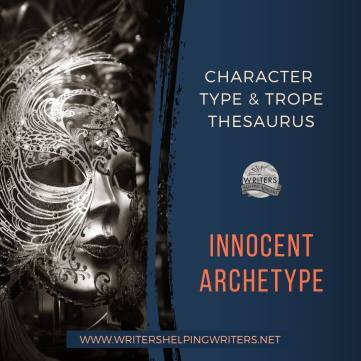 Innocent Archetype
Innocent ArchetypeDESCRIPTION: Innocents are goodness personified. They are morally grounded, optimistic, see the light in others, and view the world as a safe and wonderful place. They are gentle and caring, walk playfully through the world with the best intentions, and will always try to do what is right.
FICTIONAL EXAMPLES: Dorothy (The Wizard of Oz), Forrest Gump (Forrest Gump); Charlie Bucket (Charlie and the Chocolate Factory)
COMMON STRENGTHS: Adventurous, Affectionate, Appreciative, Centered, Charming, Courteous, Creative, Curious, Generous, Gentle, Happy, Idealistic, Imaginative, Innocent, Kind, Obedient, Playful, Trusting
COMMON WEAKNESSES: Flaky, Frivolous, Gullible, Needy, Subservient, Verbose
ASSOCIATED ACTIONS, BEHAVIORS, AND TENDENCIES
Gravitating to people with strength or authority
Asking questions & displaying curiosity
Noticing the little things
Appreciating small simple things
Giving others compliments
Being polite
Giving people the benefit of the doubt
Taking people at their word
Always finding the silver lining of a situation
Being less adept at picking up on sarcasm, double-speak, or deceptiveness
Voicing the positives in every situation
Smiling and acting upbeat
Being kind to everyone and everything
Rarely getting mad or upset
Feeling hurt when someone shouts or snaps
Building friendships quickly and easily
Turning the other cheek quickly and not holding onto things
Saying what they mean, being open and honest
Being gifted at bringing people together
Voicing the questions that others won���t ask
Trying to make others happy in small ways
Being unafraid to call out wrongs even if it���s dangerous or could cause problems, because it���s the right thing to do
SITUATIONS THAT WILL CHALLENGE THEM
Wanting people to be equal and care for each other but not knowing how to make that happen
Wanting to help others but feeling in need of help and protection themselves
Being in a competition
The realization that they are being manipulated (and the subsequent pain of a loss of trust)
When they need to set boundaries or be assertive
When someone is trying to take advantage of them
When situations are complicated or political instead of simple and straightforward
Being in a situation where they must make the decisions rather than another
INNER STRUGGLES TO GIVE THEM DEPTH
Having to make a choice where someone will suffer as a result
Feeling disillusioned when exposed to the darker side of people
Wanting to be independent but lacking the confidence to get there
Suspecting someone of lying but not wanting to rock the boat
Struggling over what to do with negative feelings
Wanting to forgive someone but finding it hard to do
TWIST THIS TROPE WITH A CHARACTER WHO���
Is an older character who has maintained their innocence
Comes to realize their moral beliefs were flawed and they must calibrate
Is someone who never gives up their hope and sense of wonder in a world that has as much darkness as light
An innocent who inspires others and through that inspiration, becomes a great leader
CLICH��S TO BE AWARE OF
Innocents who never seem to ���wise up��� after being repeatedly taken advantage of
Innocents who are quick to forgive being portrayed as ���weak���
Innocents being betrayed as a device to show the reader just how bad or evil another character is
Other Type and Trope Thesaurus entries can be found here.
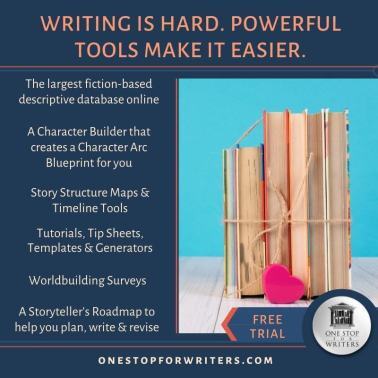 Need More Descriptive Help?
Need More Descriptive Help?While this thesaurus is still being developed, the rest of our descriptive collection (16 unique thesauri and growing) is accessible through the One Stop for Writers THESAURUS database.
If you like, swing by and check out the video walkthrough for this site, and then give our Free Trial a spin.
The post Character Tropes and Types: Innocent appeared first on WRITERS HELPING WRITERS��.
May 24, 2023
How a Show-Don’t-Tell Mindset Helps You Write Stronger Stories
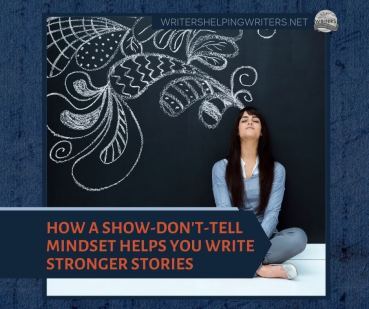
Show-Don’t-Tell is something we hear a lot about as writers, and yet many struggle to apply it. Why? Because while most understand the basics of show-don’t-tell, not every writer can spot descriptive opportunities where deploying it the right way will draw readers in.
Becca and I have studied description extensively and trained ourselves to spot these opportunities by adopting what we call a Show-Don’t-Tell Mindset. To help you do the same, we’ve created a recorded webinar on our process: Think Like a Story Expert: How to Engage Readers Using Psychology & the Show-Don’t-Tell Mindset.
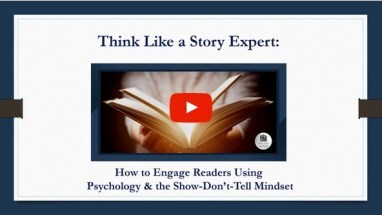
In it, I’ll show you how we identify details that can connect the story dots for readers, add depth, and how leveraging psychology will help you connect readers to your characters so they care and become invested in what happens next.
This isn’t a long webinar, but it’s packed with takeaways to help you strengthen your stories. So if you’d like help in this area, give it a watch, and happy writing!
More Show-Don’t-Tell Help
Show-Don’t-Tell Resource Page
Free Show-Don’t-Tell Pro Pack
One Stop for Writers’ Show-Don’t-Tell Database
Mastering Show-Don’t-Tell
The post How a Show-Don’t-Tell Mindset Helps You Write Stronger Stories appeared first on WRITERS HELPING WRITERS��.
May 22, 2023
Should You Write Over the Summer, or Take a Break?
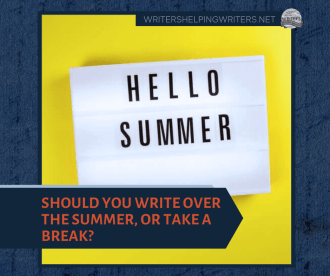
We’re a month away from the official kickoff to summer, and as someone who gets less of this season than many (Oh, Canada), I’m starting to get giddy. Summer is ahead, ready to unfurl like a warm, sunny rug. I’m talking longer days, less rigid schedules, and more trips to Gong Cha for bubble tea. Let the good times roll.
Some writers may be looking to take the next few months off from writing, or shift focus to other writerly tasks. Others have no such plans, and will be full steam ahead as usual.
I want to make room to enjoy summer, but I’ll still be working, balancing writing and research with the other things on my plate, and frankly, I’m good with that. I’m the type of person who needs to know I’m furthering the ball when it comes to my goals, even if it’s at a slower pace.
Writing over the summer is glorious because…We can move our office wherever we want. I love being able to take my laptop outside and work on the sun-dappled balcony in the morning, or pull a deck chair into the shade during the afternoon. Sometimes I decide it’s a take-your-adult-beverage-to-work-day, because why not? Summer!
We can tap into greater creativity. Writing outside, or even with just the windows open, brings us birdsong, the shush of leaves, and perfumed air of flowers and greenery. Color is everywhere, too, visual reminders that everything is growing, coming into its own, just as we are with each word we write.

We can take our stories on the road. Is there anything better than taking a notebook on a walk, finding a quiet park or place along the river, and just letting our imagination flow? Getting out from the desk is a powerful way to reconnect with creativity and spontaneity (and it keeps us from losing hours to scrolling tiktok videos).
We have more energy. Summer tends to mean less activities and a slower pace as schools close and people at work rotate through holidays and vacations. With less pressure in these areas, we have more time for ourselves, and more mental energy for our books.
A break from writing can be beneficial because…Life can be stressful, and sometimes we just need a break. Between work, family, social commitments, and unexpected life hurdles, sometimes the last thing we need is to fill a gap of time with more of anything. It’s okay to take time for yourself, and you shouldn’t feel guilty about not writing, especially if you are a bit burned out.
You just wrapped up something big, and need rest. Last year, my life was nuts. In a span of three months, both my children were married, I moved, and my husband was admitted for major surgery. With so many big life events happening all at once, I needed some downtime in the worst way, so I took it without regret.
You’re struggling with Writer’s Block. When retrieving words seems impossible, sometimes you need to keep trying, but other times, stepping back is the better choice. The dreaded block often happens because the creative well is empty, meaning it needs to be refilled. Read, get out in nature, watch movies, do art, bake, and do all the things that tend to make you feel creative and feed your imagination. When you are itching to get back to writing, you’ll know.
Or…strike a balance!
Few things are all-or-nothing, including your summer writing (or not-writing) strategy. If you have visitors to prep for, weekend camping trips, or this is the year you renovate the yard, it might be difficult to work on your novel with regularity. But if you’re like me and get a bit squidgy when you feel as if you aren’t furthering your writing goals, look for middle ground. One way might be to choose bite-sized tasks over a steady word count.
Think about where you are now, and where you want to be. Make a list of things that you need to know to have a clearer picture of your path forward. Do you need to research publishing options? Get a query letter & list of agents ready to go? Do you need to find a course to help you market, or create a shortlist of reputable freelance editors? Whatever things you believe should be in your headlights, make a list. Order it so what you need to get started on first is at the top.
Do some research. Being a writer means there’s always more for us to learn. Maybe it’s time to research website hosting, play with design tools so you’ll be able to create promotional materials down the road, or find answers to your publishing questions. Summer is a great time to visit new sites, test tools, and find resources that can help you take the next step.

Plan a new story. Summer is the BEST time to dream up new characters, outline a story, or build a fictional world. These are writing bits that are fun, creative, and perfect for smaller pockets of time. Being able to mull everything over, and do some of the important planning, can put you in a great place when it’s time to start writing!
You even have the time and space to decide the best way for your story to start. Having that first scene clear in your mind can make it so much easier to get going when it’s time to write it.
If you are planning to write…
Make sure to take advantage of this 25% JUSTWRITE discount code for One Stop for Writers. One Stop for Writers not only has a host of powerful tools and the largest show-don’t-tell THESAURUS database anywhere, it also contains a Storyteller’s Roadmap, which is like having a story coach in your keyboard, guiding you step-by-step as you plan, write, and revise.
This can be especially helpful over the summer so you keep track of what comes next at whatever stage you’re in. Find out more.
What are your plans this summer – write, take a break, or something in between?The post Should You Write Over the Summer, or Take a Break? appeared first on WRITERS HELPING WRITERS��.
May 20, 2023
Character Type and Trope Thesaurus Entry: Sage
In 1959, Carl Jung first popularized the idea of archetypes���”universal images that have existed since the remotest times.” He posited that every person is a blend of these 12 basic personalities. Ever since then, authors have been applying this idea to fictional characters, combining the different archetypes to come up with interesting new versions. The result is a sizable pool of character tropes that we see from one story to another.
Archetypes and tropes are popular storytelling elements because of their familiarity. Upon seeing them, readers know immediately who they’re dealing with and what role the nerd, dark lord, femme fatale, or monster hunter will play. As authors, we need to recognize the commonalities for each trope so we can write them in a recognizable way and create a rudimentary sketch for any character we want to create.
But when it comes to characters, no one wants just a sketch; we want a vibrant and striking cast full of color, depth, and contrast. Diving deeper into character creation is especially important when starting with tropes because the blessing of their familiarity is also a curse; without differentiation, the characters begin to look the same from story to story.
But no more. The Character Type and Trope Thesaurus allows you to outline the foundational elements of each trope while also exploring how to individualize them. In this way, you’ll be able to use historically tried-and-true character types to create a cast for your story that is anything but traditional.
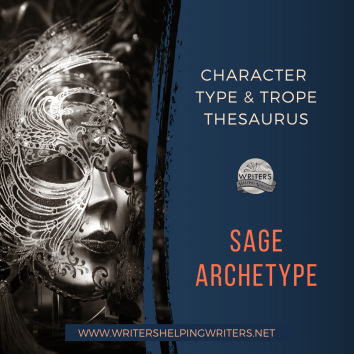 Sage Archetype
Sage ArchetypeDESCRIPTION: Sages are wise, always seeking knowledge, but they also are willing to impart their learnings to others. This makes them ideal mentors and parental figures.
FICTIONAL EXAMPLES: Mother Abagail (The Stand), Merlin (The Once and Future King), Obi-Wan Kenobi (the Star Wars franchise), Mr. Miyagi (The Karate Kid), Mr. Keating (Dead Poets Society)
COMMON STRENGTHS: Calm, Centered, Confident, Cooperative, Curious, Decisive, Disciplined, Discreet, Generous, Gentle, Honorable, Intelligent, Just, Kind, Loyal, Mature, Observant, Philosophical, Protective, Resourceful, Responsible, Spiritual, Studious, Talented, Uninhibited, Unselfish, Wise
COMMON WEAKNESSES: Controlling, Fussy, Know-It-All, Perfectionist, Possessive, Pushy, Worrywart
ASSOCIATED ACTIONS, BEHAVIORS, AND TENDENCIES
Being highly curious
Seeking truth
Being a lifelong learner
Having a specific insight that others lack
Being specialized in an area of expertise (the Force, magic, math, baseball, etc.)
Being quirky
Holding a job that is well below their potential because it allows them to help others
Considering different viewpoints (instead of dismissing or being threatened by them)
Eagerly trying new things
Thinking before speaking; weighing their thoughts and words carefully
Being a good teacher
Caring about the people they’re mentoring
Using unorthodox teaching methods
Being optimistic about people and the future of humanity
Offering unsolicited advice if doing so could help someone grow
Challenging lies, misconceptions, and biases
Thinking deeply about things
Working well with others
Not being ego-driven (dismissing slights, not fussing about getting credit for ideas, etc.)
Guiding others while sitting back and not actively participating in the fight
Being reluctant to take action until enough knowledge is gained
Making personal sacrifices in the pursuit of knowledge
Living alone (which, from a story perspective, makes it easier for the sage to mentor others)
Having a spiritual or mystical bent
Guiding their charges to find their own answers (instead of telling them what to believe)
Being perceptive���particularly regarding the hero’s weaknesses and how they should be challenged
Responding to threats calmly and carefully
Standing alone to uphold the truth or challenge a wrong
SITUATIONS THAT WILL CHALLENGE THEM
Being paired with a floundering hero who doesn’t want help
Needing to help someone who is loathsome in some way
A problem with no apparent solution
The sage’s area of expertise failing to provide the answers it always has
A physical, emotional, or mental ailment that makes learning a challenge
Being overcome by a rival
A ticking clock situation tempting the sage to cut corners or make hasty decisions
Not getting along with the person they’re attempting to mentor
INNER STRUGGLES TO GIVE THEM DEPTH
Discovering that advice they’ve given was wrong
Succumbing to temptation and letting someone down
Knowing a sacrifice is required for the hero to win but being reluctant to make it
Struggling to ascertain the correct path forward
Having a crisis of self-doubt; wondering if they’re suited to do what they’re doing, or if the people they’re trying to help are worth saving
TWIST THIS TROPE WITH A CHARACTER WHO���
Has their own arc to traverse, possibly with the help of a hero who will mentor them in some way
Has a well-developed backstory that has contributed to who they are now
Isn’t male
Has an atypical trait: frivolous, irresponsible, timid, lazy, cruel, indecisive, easygoing, etc.
CLICH��S TO BE AWARE OF
The sage living alone in an isolated area so they won’t be distracted by worldly things
A sage who makes the ultimate sacrifice to save the hero
The curmudgeonly sage the hero must win over in order to receive their wisdom
Other Type and Trope Thesaurus entries can be found here.
 Need More Descriptive Help?
Need More Descriptive Help?While this thesaurus is still being developed, the rest of our descriptive collection (16 unique thesauri and growing) is accessible through the One Stop for Writers THESAURUS database.
If you like, swing by and check out the video walkthrough for this site, and then give our Free Trial a spin.
The post Character Type and Trope Thesaurus Entry: Sage appeared first on WRITERS HELPING WRITERS��.
May 17, 2023
Phenomenal First Pages Contest – Guest Editor Edition
 Hey, wonderful writerly people! It���s time for our monthly critique contest. This month, we have a HUGE prize.
Hey, wonderful writerly people! It���s time for our monthly critique contest. This month, we have a HUGE prize. 3 winners will receive feedback on 20 pages from a professional editor. So exciting! How to enter:
Leave a comment. Any comment :). As long as the email address associated with your WordPress account/comment profile is up-to-date, I���ll be able to contact you if you are chosen. Just please know that if I���m unable to get in touch with you through that address, you���ll have to forfeit your win.
Here’s the editor you’ll be working with:Stuart Wakefield
With 26 years in theatre, broadcast media, and coaching under my belt, I have a visceral understanding of what makes stories work, and I���d like to share it with you because writing a novel doesn’t always have to be difficult and daunting, especially if it���s your first time. Understanding the process, getting started, and seeing it all come together can seem like an impossible mountain to climb.
As an Author Accelerator Certified Book Coach, I’m passionate about helping new writers craft stories with passion and purpose, momentum and meaning. I have an MA (Distinction) in Professional Writing, and my debut novel, Body of Water, was one of ten books long-listed for the Polari First Book Prize. My latest novel, Behind the Seams, was a 2021 BookLife Fiction Prize Contest semifinalist.
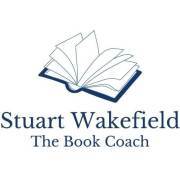
My first TV show is airing on the UK’s Channel 4 in 2023.
So, if you have a story in your heart, just waiting to be shared with the world, I���m here to offer you guidance and support from developing your story right through to pursuing publication. You can find my website, blog, and free self-editing cheat sheet right here: https://linktr.ee/thebookcoach
Contest GuidelinesPlease be sure your first 20 pages are ready to go so Stuart can critique them before next month���s contest rolls around. 1-inch margins, double-spaced, and 12pt Times New Roman font. Feedback will consist of in-line comments concerning what’s not working and what is.You’ll need to have a synopsis ready (a rough one is fine) so Stuart can make sure his feedback is in context. This contest only runs for 24 hours, start to finish, so get your comment in there!Three commenters��� names will be randomly drawn and posted tomorrow morning. If you win, I’ll contact you with information about sending it to me. Then, I’ll forward it to our amazing editor for feedback.
We run this contest on a monthly basis, so if you���d like to be notified when the next opportunity comes around, consider subscribing to our blog (see the right-hand sidebar).
Good luck! I can’t wait to see who the winners will be. 
PS: If you want to amp up your first page, grab our helpful��First Pages checklist from One Stop for Writers. And for more instruction on these important opening elements, see this��Mother Lode of First Page Resources.
The post Phenomenal First Pages Contest – Guest Editor Edition appeared first on WRITERS HELPING WRITERS��.
May 16, 2023
Character Voice Versus Author Voice

We���ve all heard about the importance of finding your voice as a writer. Maybe you���ve had a critique from an editor who felt the narrative voice wasn���t sharp enough. Or maybe a critique mentioned the author���s voice creeping into the narrative and you found yourself thinking, huh? Isn���t that the voice I worked so hard to develop in the first place?
Well, yes. And no.
We each have a voice that we write in, and it���s as individual as a fingerprint. A novel by Margaret Atwood will sound different than one by Stephen King, and while this might be related to both genre and characters, there���s an ineffable quality to each author���s voice that seeps into their work regardless of how hard they might try to keep it out.
The trick is not to let that voice break the fictional dream you���ve created in your work.
This can happen in several ways: when the author has an agenda they���re trying to slip into the story; when they inadvertently break the POV by stepping in to comment on something; and when they succumb to the temptation to use what Elmore Leonard calls hooptedoodle.
Having an AgendaWhen we write a novel, we often (hopefully) have something to say. Let���s call it a theme, the answer to the dreaded so what? question. The line between theme and message, however, is a thin one, and if you���re not subtle enough about your intentions, your reader will sense you���re trying to teach them something and will back away.
Having something to say should not be the same as telling readers what to think. It���s always better to give readers questions to ponder rather than answers to swallow. So, if you have an agenda, shelve it. Give us something to think about. But don���t tell us we have to think like you.
As Ursula le Guin so elegantly puts it, a story���s job is to achieve meaning; it���s a door that opens onto a new world. Messages are for sermons. If all you see in The Hobbit is a message about greed, you���ve missed the magic.
Let the Narrator Narrate
When the author���s voice creeps into a defined POV, you pull your reader out of the fictional dream. It���s jarring. In fact, this gets to the heart of POV, where consistent character voice is crucial to reader immersion.
In any deep POV you choose, you���ll be seeing the world through someone else���s eyes. That means everything���from what they notice to the analogies they draw���must be filtered through a lens that is not your own. Douglas Glover calls this language overlay, and it���s one of the most useful POV pointers I���ve ever come across. A sailor will not think the same way as a baker, and this difference can run deep. As an example, the sailor might always have one eye on the weather; a baker might be perpetually attuned to smells. Your teen narrator who suddenly knows the Latin names of plants will pull readers out of the story scratching their heads and wondering how this narrator has such easy access to this specialized information. Not to say it can���t work. If the narrator���s mother is a botanist and has been teaching him the Latin names of plants from the time he was a toddler, it will add another layer to his character. But that has to be established in the story.
An objective POV is all about what can be seen on the surface, so the author���s voice definitely shouldn���t be part of that. And in omniscience, there is still a narrator���but unless it���s you, the reader shouldn���t hear your voice.
Avoid HooptedoodleOur name might be on the cover of the book we���ve written, but we should never take center stage in our novel unless we���re doing something funky with metafiction. One of the ways we sneak ourselves into our work is with fancy writing that calls attention to itself for no other reason than to wave a flag and say look what I can do.
I���m a huge fan of poetic writing, but I���m also a firm believer in the importance of double duty. Every element in a novel should do more than one thing. A pretty description of the weather should also be a reflection of mood or an ironic foreshadowing or whatever else you have up your sleeve. If you���ve written a whole paragraph about the dark billowing sky, let it also reflect a building dread in the narrator or allow it to serve as a reminder that the body he dropped into the lake might not have been weighted down with enough rocks.
But if that billowing sky is only there for the reader to admire, then it sounds like writing. And as Elmore Leonard also said: ���If it sounds like writing, I rewrite it.���
Do your readers a favor: either take it out or give it a second job.
Finding Your Voice
The notion of finding your voice has never made sense to me. Your voice is who you are. No matter whose shoes you���re wearing in a particular novel, your voice will come through. If you don���t believe that, try reading one author���s entire body of work. You���ll meet a room full of characters who might all sound different, but there will also be something humming beneath them that they share: the person who created them.
You don���t have to find your voice. You are your voice.
What you have to do is write. A lot. Learn how to handle POV so that you, the author, remain the silent partner in this weird agreement you make with your readers when you bring a world to life. Don���t remind the reader that they���re reading a story. Allow them to believe in the dream.
As for crafting a character���s voice, well��� that���s a topic that deserves its own post. Which it will have next time you see me here.The post Character Voice Versus Author Voice appeared first on WRITERS HELPING WRITERS��.
May 12, 2023
Character Type and Trope Thesaurus: Explorer
In 1959, Carl Jung first popularized the idea of archetypes���”universal images that have existed since the remotest times.” He posited that every person is a blend of these 12 basic personalities. Ever since then, authors have been applying this idea to fictional characters, combining the different archetypes to come up with interesting new versions. The result is a sizable pool of character tropes that we see from one story to another.
Archetypes and tropes are popular storytelling elements because of their familiarity. Upon seeing them, readers know immediately who they’re dealing with and what role the nerd, dark lord, femme fatale, or monster hunter will play. As authors, we need to recognize the commonalities for each trope so we can write them in a recognizable way and create a rudimentary sketch for any character we want to create.
But when it comes to characters, no one wants just a sketch; we want a vibrant and striking cast full of color, depth, and contrast. Diving deeper into character creation is especially important when starting with tropes because the blessing of their familiarity is also a curse; without differentiation, the characters begin to look the same from story to story.
But no more. The Character Type and Trope Thesaurus allows you to outline the foundational elements of each trope while also exploring how to individualize them. In this way, you’ll be able to use historically tried-and-true character types to create a cast for your story that is anything but traditional.
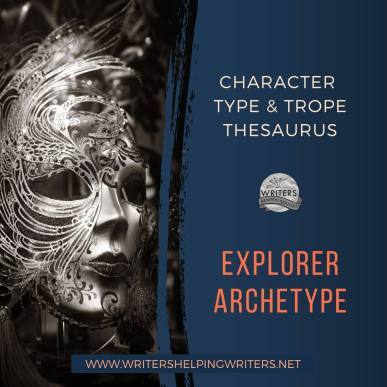 Explorer Archetype
Explorer ArchetypeDESCRIPTION
Explorers thrive on adventure and discovery. These trailblazers are unafraid of new experiences or challenges, and boldly moving into the unknown is a part of their identity.
FICTIONAL EXAMPLES: Indiana Jones (Indiana Jones Series), Captain Picard (Star Trek), Lara Croft (Tomb Raider), Evelyn O’Connell (The Mummy Franchise)
COMMON STRENGTHS
Adaptable, Adventurous, Ambitious, Appreciative, Bold, Confident, Curious, Decisive, Focused, Idealistic, Independent, Observant, Passionate, Persistent, Resourceful, Spontaneous, Wise
COMMON WEAKNESSES
Abrasive, Cocky, Impatient, Impulsive, Macho, Manipulative, Obsessive, Possessive, Rebellious, Reckless, Selfish, Stubborn, Temperamental, Withdrawn, Workaholic
ASSOCIATED ACTIONS, BEHAVIORS, AND TENDENCIES
Nomadic tendencies (being on the move, never staying too long in one place)
Not needing much in the way of creature comforts
Having fewer attachments (to things, people, places)
Having a broad understanding of people, cultures, and customs
Knowing more than one language
Being highly spontaneous
Being a ‘figure it out as I go’ sort of person
Having a strong sense of purpose and a clear goal at all times
Able to think on their feet and adapt to changing circumstances
Being able to learn the rules of a new environment quickly
Excellent survival and navigation skills
Recovering from disappointments quickly and moving on
Being drawn in by stories
Being curious about people, places, and experiences
A desire to see and experience things first hand
Always being up for a trip, outing, or adventure
Being unafraid of new circumstances or challenges
Being a thrill-seeker
Not being turned off by danger or risk
More likely to act on instinct rather than through a deep analysis
The ability to size people up quickly
Needing to be talked out of things, rather than talked into them
Preferring their own company to the company of others
A tendency to believe the ends justify the means (when they believe in the cause)
Being a lifelong learner
Focusing on the journey, not the goal
A tendency to push to find their own limits (and then push to challenge them further)
Fearing a boring life more than anything else
SITUATIONS THAT WILL CHALLENGE THEM
Having no choice but to wait because another is in control of when things happen
Having to adhere to a routine
Being unable to travel (due to illness, legal restrictions, an injury, family responsibilities, etc.)
Being anchored by duty (becoming a caregiver to an elderly parent, having to run a family business, raising a child, etc.)
Being bound by rules and limitations
Having to give up personal freedom to serve the greater good
Being stuck in a single place for too long
Finding time for healthy, two-way relationships
Finding someone to talk through their feelings or struggles because while they may know a lot of people, few are close enough for those type of conversations
Being around people who are closed-minded and see the world in absolutes
INNER STRUGGLES TO GIVE THEM DEPTH
Feeling selfish for wanting to be out discovering new things when it means others must stay behind and pick up the slack
Wanting to have relationships but knowing the other party will only end up feeling neglected
Feeling guilt for abandoning people when the next adventure calls
Guilt over risk-taking that impacts others negatively
Regret over what they chose to give up (possibly a place to call home, close family bonds, a life partner, etc.)
Knowing the personal growth they seek may come at the price of a lonely life
TWIST THIS TROPE WITH A CHARACTER WHO���
Finds ways to be dependable while making room for adventure
Gives back as a teacher or leader who encourages others to embrace open-mindedness
Becomes a role model to someone who is dependent or insecure, showing them how to become more independent
Is an explorer who is unselfish, putting the needs of others first
CLICH��S TO BE AWARE OF
The ���lone wolf��� adventurerThe explorer who inspires deep loyalty despite never being around to nurture relationshipsThe adventurer who only travels to far off, obscure placesBeing a collector of antiquities and objects when the lifestyle doesn���t support materialismOther Type and Trope Thesaurus entries can be found here.
 Need More Descriptive Help?
Need More Descriptive Help?While this thesaurus is still being developed, the rest of our descriptive collection (16 unique thesauri and growing) is accessible through the One Stop for Writers THESAURUS database.
If you like, swing by and check out the video walkthrough for this site, and then give our Free Trial a spin.
The post Character Type and Trope Thesaurus: Explorer appeared first on WRITERS HELPING WRITERS��.
May 11, 2023
Creating a Publication Timeline for Your Next Release
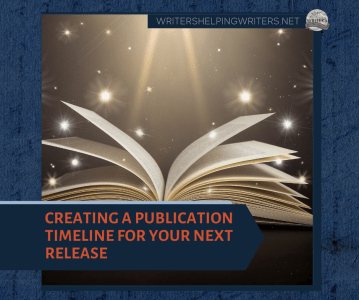
Publishing your own book is a lot like juggling���and not those harmless little balls, either. Try a couple of balls, a chainsaw, a set of Ginsu knives, and a litter of kittens. There are so many things to remember, and they���re all vital to getting your book into readers��� hands in a reasonable timeframe. Drop any of those balls and you end up with a messy or unfinished product that doesn���t reflect the time and energy you���ve put into it.
One thing Angela and I started doing early in our career was creating a publication timeline for each book. This allowed us to track the things that had to get done, plan how long each step would take, and determine a reasonable launch deadline.
These timelines have been crucial to us being able to release our books in a timely fashion without forgetting anything important. And eight books later, we���re still using the same template. Today I���d like to share my process with you so you can do the same.
1. Make a List of Tasks Needed to Publish Your BookWhat jobs will need to be done for your book to be published? Some of these are universal���writing the book, revising it, designing a cover, etc. But others will be specific to you and the kind of book you���ve written. To get you started, here���s our list of Must-Dos, which can be tweaked to fit your process.
Drafting: Each nonfiction book that Angela and I write consists of two portions: instructive front matter and thesaurus entries. We tackle each section separately, so they���re listed as such on our spreadsheet.
Revision: The length for this part of the process will vary between authors and from project to project.
Professional Editing: We���ve come a long way from the self-publishing stigma that was so pervasive when we published our first book in 2012. A lot of that is due to authors recognizing the need to create a polished product. When you���ve done as much with your manuscript as you can, hire a professional to take it to the next level. Because of the unusual format of our nonfiction books, Angela and I hire an editor to tidy up the narrative front matter and a proofreader to fine-tooth-comb the entry section, but that won���t be necessary for everyone.
Drawer Time: After so much time focusing on a book, we start to lose perspective; we���re so close to it that we can no longer see the issues. To gain a little distance, stick it in the ���drawer��� for a while. Work on something else. Then, when you come back to it, you can give it a final read-through with fresh eyes to catch anything you may have missed.
Cover Design: Whether you do it yourself or hire someone, you���ll need to create a cover for your book.
Formatting: This is the final step in the process of creating the actual book. Again, you can do this job yourself or hire it out.
Marketing for Your Launch: What���s your marketing plan? How will you get the word out about your book? Make note on your timeline of the different strategies you���ll employ, such as crafting a launch-related newsletter, soliciting testimonials, hiring a street team, or sending out requests to write guest posts for influential blogs around the time of your release.
Publishing: Decide where you���re going to sell your books (Amazon, Apple, on your website, etc.). Familiarize yourself with their timelines so you���ll know how long it takes for an uploaded file to be available for purchase. This will ensure that your books can be bought at the various distributors by your launch date.
Miscellaneous Pre-Launch Stuff: There are lots of nitpicky tasks that need to be done before your book goes live: creating blurbs, updating your bio, adding the book to your website bookstore, obtaining an ISBN���all the little things that don���t fit into bigger categories. Dropping them into a Miscellaneous section on your timeline is a good way to remember them so they don���t creep up on you.
Other Considerations: Our spreadsheet isn���t comprehensive; it excludes a lot of common tasks such as obtaining feedback from beta readers and setting up preorders. And that���s fine. Everyone���s process is different. As you set up your own timeline, you can include anything we���ve omitted and remove the tasks that aren���t necessary.
Once you���ve created your list of tasks, put them into a spreadsheet, as follows. Then you���re ready for the next step.
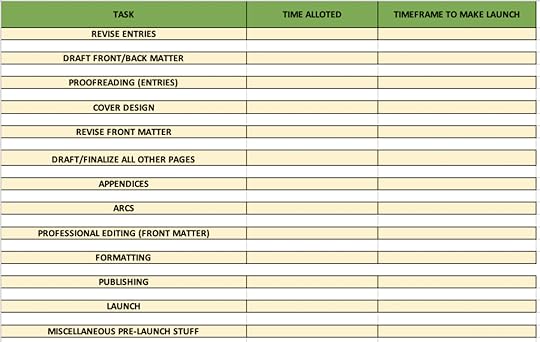 2. Split Tasks into Subtasks
2. Split Tasks into SubtasksSome jobs will require multiple steps. You want to note these under each task so you don���t forget them.
3. Assign Time Estimates for Each Task and Subtask.If you���ve written books before, you���ll know how long it will take to draft, revise, and the like. If this will be your first time, make your best guess; you can always adjust, as long as you���ve added enough buffer into your overall timeline (more on that later). For tasks that will be handled by others, decide early on who you���ll be working with. Ask them in advance how long they���ll need to complete your cover design or format a project like yours. Add time estimates for each task and subtask to your spreadsheet. Here���s how our timeline started for The Occupation Thesaurus:
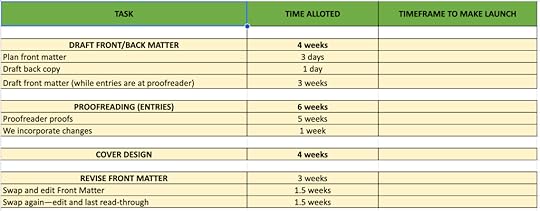 4. Order Your Tasks.
4. Order Your Tasks. Most of the steps to publication go in a logical sequence: drafting, then revising, then formal editing, etc. But some jobs can overlap. For instance, you may decide to do your cover design or beta reading during that important drawer time. You might be able to start some marketing incentives while the book is still being formatted. Arrange your tasks so you can see the order in which they need to be accomplished.
5. Decide on a Launch DateNow that you know the tasks you���ll be handling and how much time is needed for each, you can decide on a release date. Add up the time allotted for all the tasks to see how much will be needed overall. Then get out the calendar and choose a launch date that will give you enough time to do everything on your list. Be sure to plan around family vacations, holidays, big work projects, and any other events that would make it difficult for you to focus on your launch.
One other thing you���ll want to factor into your timeline is what I like to call Buffer. No matter how carefully you plan, things go wrong. Your cover designer goes out of business and you have to find a new one, beta feedback requires you to make major changes, a family situation crops up that steals your writing time ��� Trust me, you will need more time than you think you do, so add some buffer into your timeline. You won���t see it on our sheet because I don���t physically add a line item for buffer; I just add an extra 3-4 weeks to the overall timeframe and choose a launch date with that in mind. This may sound like overkill, but Angela and I have needed at least some of that buffer for every release. And if you end up finishing ahead of schedule, great. You���ve got some time to breathe before jumping into your marketing campaign.��
6. Work Backwards to Assign Timeframes to Each TaskOnce you���ve got a launch date in mind, work backwards from that date to fill in the timeframes for each task so you���ll know when each one needs to be done. For The Occupation Thesaurus, we needed about 4 1/2 months, including buffer, so we decided to shoot for a release date of 7/20. The item on my spreadsheet that���s just prior to launch is Publishing. Seeing that I have to upload and publish my digital files at various distributors five days before launch, I plan to do that on 7/15. Next, I���ve got a note that my Amazon files should be published a week before the release date, so I���ll do those on 7/13. Print files have to be uploaded even earlier, because I have to order a proof and make sure the paper copy looks good. I allot three weeks for that (in case anything goes wrong and I have to make changes and order a second proof), so I plan to upload the print file three weeks before launch, on 6/23.
That takes care of all the publishing tasks. So I move up to formatting. My formatter needs about three weeks, so I plan to get her the material on 5/25 in hopes that I���ll have the finished files by 6/19. Then I move on to the task that comes before formatting���

In this way, work your way backward until you���ve assigned dates for all the tasks. This process will tell you when, at the latest, you should start working through your list so you���ll be done in time for your launch. And it acts as a schedule to keep you on track as you go. Here���s what ours looked like for this particular publication:

This may seem like a lot of work, but it���s worth it because you only have to do it once. Then, when it���s time to publish your next book, the spreadsheet is there, with the necessary tasks and timeframes laid out. All you have to do is adjust the dates so they fit your new launch date. It makes things SO much easier.
This sheet is also handy because it allows you to note what doesn���t work so you can make changes for the next publication. For instance, prior to this publication, we���d always sent out ARCs as PDFs after the book was formatted (so readers had the cleanest version to read). But we learned that if readers find typos and other errors, it was too late for us to go back and remove them because the files had already been formatted. We made a note for future publications to create a quick PDF from the manuscript and send those out as ARCs before we got to the formatting stage so we could incorporate any changes before the files were finalized.
This timeline has been an absolute lifesaver for us and has made the jump to self-publishing much more manageable. And it can do the same for you. We���d love for you to use our spreadsheet as a template and individualize it to fit your next project. And if you have questions about the process, I���m here to answer them.
The post Creating a Publication Timeline for Your Next Release appeared first on WRITERS HELPING WRITERS��.
May 9, 2023
How Beta Readers Might Save Your Book from Disaster

When I wrote book 2 in my The Fountain Series, The West Woods, I posted on social media to get Beta Readers, and had 61 people offer. *Facepalm*. I didn���t want to sift through 61 opinions on my book, but I did need a gut check from fans of the series.
Would they like it as much as Book 1?Would they accept that Book 2 is a prequel?Would they forgive my main character, Courtney, for the things she did in Book 1?These were the worries I had. So, from the 61, I invited a dozen, including teens and adults who read Young Adult. (Fun fact if you write for Young Adults ��� Adults are the ones who buy the books, and also the ones who review them, because kids don���t have Amazon accounts, so you need to make sure your book satisfies them too!)

Now, if you are lucky enough to find Beta Readers, treat them like gold. They are not your proofreaders. They are not editors. And unless they are also writers, they may not have the skills to suggest how you can improve your book. The skill you need from them is being readers, and letting them react to the story you���ve written.
Many of my Beta Readers have never given a writer feedback before, so I make it as clear as possible what I need them to do. That way, they don���t have to stress that they���re ���not doing it right���, or that they���ll somehow let me down if they don���t love everything about the book. Bring on the feedback, because once it���s out in the world, you can���t take it back.
Writers often ask me when to involve Beta Readers. I like to get this feedback before I send it to my editor, so that I���ve got a good idea of how others will receive it. If I���m on a short timeline, I also sometimes send it to my editor and Beta Readers at the same time and then incorporate all the changes that come out of their reviews in the same revision pass.
The first thing I do is give my Beta Readers a clear timeline. I like to ask them to read my book in 2 weeks. Here���s a quick tip: If you send your book to Beta Readers, and they don���t finish it? That might be feedback in itself. I hope that once readers start it, they rip through it cover to cover, just to find out what happens.
And to let them enjoy it and not stress, I make it clear that I don���t expect them to edit along the way. Instead, I give them a list of questions to answer when they���re done reading, including what characters they liked the most, and who they liked the least, which scene was their favorite, which was their least favorite, etc. Want the exact questions I asked Beta Readers for The West Woods? You can grab them here, I���m happy to share.
I sent PDF copies of the book to the adult readers, and I printed, bound, and mailed out hard copies of the manuscript for the teen readers (I���ve found they���re more likely to be able to read it on the go, or evenings if they don���t have to use a device). And 2 weeks later, the feedback rolled in.
I sat down to go through the feedback and look for trends, taking a deep breath. After the third set of answers, I started to relax. The book was in good shape. I wouldn���t have to gut it. A few minor tweaks and it would be off to the publisher.
I went through the adult feedback first. They enjoyed the book. They connected with the main character and her story. And every one of them said that the climax scene ��� involving a dramatic break up ��� was their favorite. No surprise there, it had everything. I���d spent a long time perfecting that moment. Readers said it was heart wrenching and raw. Exactly what I was going for.

Next, I moved on to the teens��� feedback. I read the first set of answers, and then the second��� and my shoulders crept up around my neck. The teens said the break up was their least favorite scene.
���It made me so sad I had to put the book down for a few days������I cried for her, and it just wasn���t as uplifting as Book 1���I stared at their answers, stunned. I���d been so focused on ripping my readers��� hearts out, I hadn���t stopped to consider what readers loved about Book 1. Why teens were reading the series in the first place.
After a few days mulling over how to completely rework the climax of the book, I highlighted the 5 chapters that needed to change, and hit delete. (Okay, okay, of course, I didn���t really hit delete, but I moved them into another document and never looked at them again). Spoiler alert: There is no longer a break up scene in that book, and it went on to be shortlisted as a finalist for the Aurora Awards for Best Young Adult Fiction in Canada.
I am so grateful for the teens who were brave enough to tell me what the least favorite part of their book was. And I���m grateful I asked.
Are you looking for Beta Readers for your book? Check out this terrific article.Have more questions on how to use Beta Readers effectively? Drop a comment below!The post How Beta Readers Might Save Your Book from Disaster appeared first on WRITERS HELPING WRITERS��.
Writers Helping Writers
- Angela Ackerman's profile
- 1022 followers



